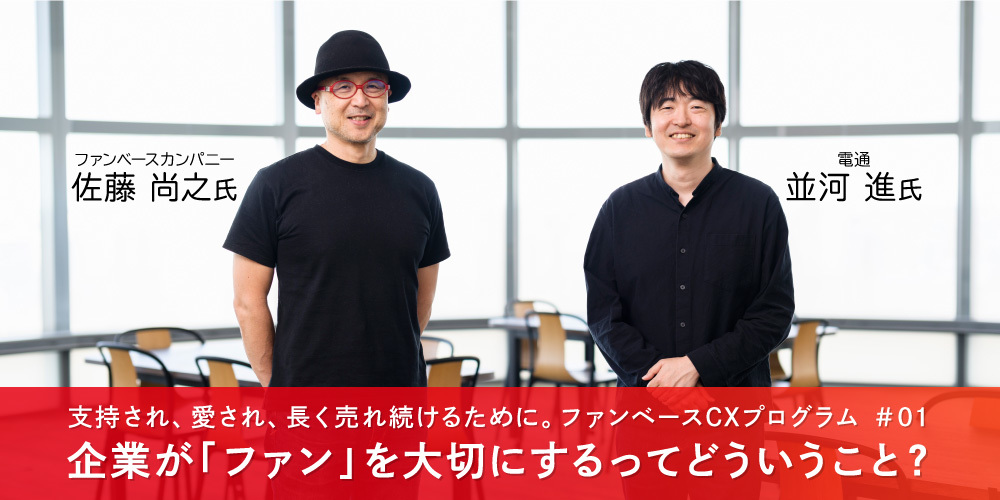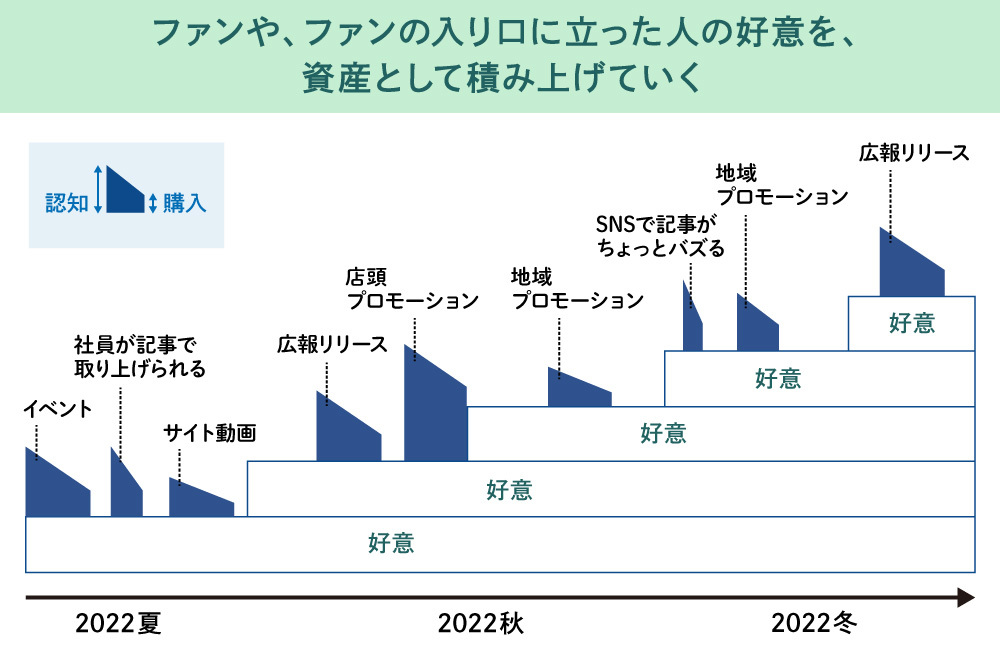Note: This website was automatically translated, so some terms or nuances may not be completely accurate.
Why Companies Should Shift Their Activities to a "Fanbase" Approach Now

Naoyuki Sato
Fanbase Company, Inc.

Susumu Namikawa
Dentsu Japan
Rapid population decline. Super-aging society. Hyper-mature markets. Information overload...
The environment surrounding companies is becoming increasingly harsh, and acquiring new customers is growing more difficult. In such times, the concept that all companies should place at the core of their activities is the "fanbase" advocated by Sato Naoyuki, known as "Satonao."
It involves valuing the "fans" who make up 20% of all customers yet generate 80% of sales, treating them as the "base" (supporting foundation) of corporate activities to increase sales and value over the medium to long term. Therein lies the key to corporate growth.
This time, Susumu Namikawa of Dentsu Inc., who is advancing collaboration with Sato's Fanbase Company, learned the fundamentals of the fanbase concept.
Related article: "Fanbase" Makes the World More Enjoyable. Sales Accelerates It.

The world is flooded with vast amounts of information, making "communication" increasingly difficult.
[3 Reasons Fanbase is Inevitable]
1. Fans support and grow the majority of sales
2. Valuing fans has become increasingly important due to the times and society
3. Fans create new fans
Namikawa: Satonao-san wrote the book "Fanbase" in 2018, about five years ago. Now, in my interactions with clients, I sense many companies are prioritizing fanbases. First, could you tell us why you wrote this book?

Sato: I spent 25 years at Dentsu Inc., where I worked on "using advertising power to expand awareness and increase market share for new clients." Around the time I wrote the book "Tomorrow's Advertising" in 2008, I began developing the field of communication design.
Back in 2008, the advertising industry still prioritized evaluating media—debating whether TV was stronger or the internet was stronger. But what matters more than the strength of media is "reaching the consumer." The media that reaches that consumer is the good media. With that in mind, I was trying to design communication by freely combining media, centered on the consumer. Even then, I already felt a sense of despair that "advertising just doesn't get through anymore." And indeed, within a few years after that, it really did stop getting through.
Namikawa: That's the point made in the book about how traditional "new customer acquisition" methods stopped working.
Sato: However, it's often misunderstood. It's not that trying to increase awareness among new customers itself became ineffective. But because the success rate dropped significantly, we proposed building a different "base" – the fan base.
Why did the success rate drop? Simply put, there's too much information. In 2020 alone, the world generated 59 zettabytes of data. Since one zettabyte is said to be equivalent to the number of grains of sand on all the world's beaches, well, it's infinite times infinite. In this environment, getting people to see the important information a company sends out is nothing short of miraculous. And even if they do see it, they won't remember it.
And there's simply too much content. It's said it would take 82 years to watch every YouTube video uploaded in a single day. Beyond that, there are video streaming sites, social media, audio media, TV, radio, newspapers, and magazines. With Japanese people having only about 2.5 hours of free time on weekdays, and with such an infinite amount of information and entertainment available, it's difficult to get people to see ads exactly as companies intend.
Many companies struggle with this: they launch massive ad campaigns to acquire new customers, and even if they generate buzz, it fizzles out after a brief surge. Campaigns become mere temporary stimulants, quickly forgotten, failing to create synergy with subsequent campaigns. It's a fragmented situation. Repeating this cycle felt like a waste of precious budget.
Namikawa: Indeed, with media and content exploding, the traditional approach of reaching everyone simultaneously through mass media is becoming increasingly difficult.
Sato: On the other hand, Japan's population is rapidly declining. It's projected to decrease by about 30 million people over the next 30 years. Add to that an ultra-mature market and a super-aged society. We have this situation on top of an excessive amount of information and content. Making products or services that attract new customers a hot topic, as we did before, is becoming incredibly difficult. We fundamentally had to change our way of thinking.
So, I had become quite pessimistic about companies "communicating" with consumers. But I realized there is one breakthrough. In this world overflowing with information, the most trusted source is overwhelmingly "family and friends." They are trusted far more than experts, media, celebrities, or influencers.
When you think about it, it makes perfect sense. In an era where information and media are infinite, and searching doesn't even reveal where the correct information lies, people trust information most from those whose values align most closely with their own—I call them "birds of a feather." In the book, I cited data from Edelman Japan's 2016 study, but when our company re-examined this in 2022, the trend had accelerated even further—family and friends are now trusted even more.

Sato: So, in this "era where messages overwhelmingly fail to reach people," the only route we should seriously consider is "recommendations" from trusted family and friends. We should rebuild advertising communication around that core.
Namikawa: I see. Essentially, word-of-mouth, right?
Sato: Exactly. That is precisely the most reliable route in today's world. And who are the strongest advocates for companies, brands, and products through word-of-mouth? It's the "fans." Fans are the ones who strongly recommend to family and friends who share similar values (birds of a feather), exerting significant influence.
Another crucial concept here is the "Pareto Principle." As you know, it states that "20% of fans generate 80% of sales." I've researched this extensively, and it holds true for nearly every product, service, and subscription model. Over the long term, you can clearly see that "20% of fans" repeatedly purchase and drive the majority of sales.
In a world of rapidly shrinking populations, fighting over new customers is a path to hell. Instead, I believe it's become essential in this era to first value the 20% of "existing fans" who support 80% of your sales. By focusing on and delighting your existing fans, you increase their "fan-ness." If they buy more, sales gradually climb. This approach focuses on increasing each fan's "LTV" (Lifetime Value). Moreover, recommendations from fans to like-minded friends are highly effective. Since like-minded friends share similar sensibilities, they are highly likely to become new "fans."
Namikawa: So, the fundamental concept of a fanbase is to use existing fans as the foundation, leveraging both the "LTV of fans" and "recommendations from fans" to grow the company or brand.
Sato: Exactly. While it lacks short-term explosive power, delighting fans leads to a gradual, steady increase in sales over the medium to long term. The core of the fanbase approach is to build on this "base" of fans, combine it with traditional campaign methods, and drive sales through a mix of medium/long-term and short-term strategies.
*LTV: Lifetime Value. The total value a single customer brings to a company over their entire relationship.

Fanbase is neither "fan marketing" nor "fan business"!
Namikawa: Regarding the term "fanbase," could you share your definition of it?
Sato: Literally, it's the concept of building a base (support base, foundation) from fans. Similar terms like "fan marketing" or "fan business" exist, right? I strongly dislike the idea of "marketing fans" and vehemently oppose it (laughs). The moment you say "marketing," it inevitably carries this top-down, all-powerful sense of trying to manipulate fans to do what you want. But fans are partners who grow the brand together. Partners aren't subjects to be moved through marketing. Similarly, the term "fan business" feels like it implies trying to profit off fans. That kind of arrogant attitude gets seen right through by fans and leads to disappointment.
The fanbase is fundamentally a foundation for making fans happier, which in turn increases LTV and leads to recommendations from like-minded people. It's a solid base that supports the company's value and sales.
Namikawa: So for a company's activities, the existing fans form the "base," and everything else builds upon that foundation.
Sato: It's about consistently engaging with existing fans, making them happy, and steadily building that foundation. Companies tend to focus too much on new customers, but even for short-term campaigns, fans are ultimately the ones who appreciate them most. It gives them a reason to recommend to like-minded friends: "Hey, see that campaign they're running? I'm a fan!" By valuing regular fanbase initiatives and running short-term campaigns on top of that foundation, we can avoid disjointed efforts and achieve sustained, continuous results.

Sato: To summarize, combining mid-to-long-term strategies to increase the LTV of existing fans with the kind of short-term campaigns advertising agencies have traditionally run. By combining both, I believe companies can achieve steady growth.
Is "We don't have any fans" really true?
Namikawa: Going back a bit, I'd like to dig deeper into the fundamental question: What exactly is a fan? Before Satonao-san wrote his book, the image associated with the word "fan" was probably more like fans of idols or sports teams.
Sato: You know, the "Woo-woo!" kind.
Namikawa: Yes (laughs). Because that image is so strong, when talking with clients, I often hear, "We don't have fans like that." I guess they imagine the "typical fan image" – people going to live shows or sports games and getting wildly enthusiastic. But the fans Satonao-san talks about have a much broader meaning, right?
Sato: Exactly. They're supporters and people who understand. For example, even with J-League fans, people say things like, "If the team is strong, fans increase; if they're weak, fans decrease." But I don't think that's what a fan is. Fans are people who understand and support the team's philosophy on soccer, their approach to player development, their commitment to community involvement, and so on. Those people won't leave even if the team struggles. Those are the true "fans," and every company has fans like that.
Fans are people who feel "empathy," "attachment," or "trust" toward the underlying philosophy, mission, or values behind a brand or product – not just its price or convenience. People develop these feelings not for the product itself, but for the "people" behind it. Every product has human thought, effort, and stories behind it. That's incredibly important.
Namikawa: By industry, it's easy to imagine fans for car manufacturers or beverage companies, but actually, infrastructure companies and B2B companies have fans too.
Sato: Having supported fan bases for over 200 companies, I can say with certainty that fans exist across absolutely every industry. We've even held fan meetings for industrial gloves – something people without a particular interest might not even recognize. Yet, the fans are incredibly passionate. Companies are always genuinely surprised and moved when they discover, "We actually have fans?" We're thrilled too, but about 60-70% of the time, the company representatives end up crying when they meet these fans (laughs).

The first step in building a fanbase is fan meetings and active listening
Namikawa: Let's delve deeper into your earlier point about "people empathizing with people." In your book, you mentioned that as fan enthusiasm grows, it progresses from functional value to emotional value, and then to future value. First, functional value – this is something every product or service possesses, right?
Sato: Convenience, low price, high quality—things like that. Honestly, it pains me to say this since I worked in advertising, but ads often focused on functional value—the core product features—expressing them through copy and visuals. Our job was to articulate why this aspect was superior to competitors' offerings using compelling language.
But in this era of hyper-mature markets, functional value inevitably becomes stale. Competitors catch up. Even the "low price" function gets caught up in a price war. Super convenient ideas get copied left and right. That's the hyper-mature market: most products are just a race to be the best among equals.
In this era, it's not just functional value that matters; the emotional value people feel behind the product—the so-called feelings—is crucial. Competitors can copy functional value, but emotions like "empathy," "attachment," or "trust" are built through various contexts and can't be replicated. If we don't prioritize that, can we even compete anymore?
A common misunderstanding is when, for example, a copywriter suggests, "Let's define this product's emotional value as XX," and the company tries to prescribe it. Emotional value isn't something you impose like that. Based on past experience, if you don't properly listen to your fans, you'll make huge mistakes. It's not something to manipulate; you should humbly and sincerely listen to the "emotions that already exist." You need to truly listen to your fans' voices, understand what emotional value they hold for the brand, what they love about it, and grasp that as a solid insight.
Namikawa: So, as functional value becomes commoditized, it's crucial to listen to fans and discern the emotional value they attach to the brand or product. What exactly is this final element, future value?
Sato: It's the value fans feel about the future – things like the product being made without exploitation, the company being environmentally conscious, the company giving them hope, or the belief that this company might change the world.
Namikawa: That expectation that it might change the world, right? All three are important, and I don't think they can be neatly separated. But you consistently emphasize that listening to fans about emotional value is essential, Satonao-san.
Sato: Yes. While many people tend to focus on the functional value of the product, I believe it's crucial to explore what emotional value exists based on the shared insights fans hold. It's vital to identify the sweet spot – what fans like and love about the company – and ensure product development and campaigns don't miss that mark.
Namikawa: So understanding emotional value leads to greater fan delight, right?
Sato: Many people think "increasing the number of fans" is the goal of fanbase strategies. But that's not it. The core of fanbase strategy is "increasing the fan level" of the existing 20% of fans. You need to know the sweet spot of those 20% and make them happy. Otherwise, LTV won't increase, and recommendations won't happen. Increasing the number of fans essentially means trying to convert the 80% who are less committed into fans. But if you listen to that 80% and tailor your strategies to them, your core 20% of fans will be disappointed and turn away. Focusing on "fan engagement" is more important than the sheer number of fans.

Namikawa: There are various approaches to building a fanbase, but you recommend holding fan meetings to understand the emotional value fans cherish, right?
Sato: Yes. When you gather only fans and let them meet each other, it gets incredibly lively, and you get a lot of honest feedback from fans. It's full of golden nuggets. We record all of that, analyze it, and look for insights from there.
Another important point: when I say, "Listen to your fans," many people respond, "We already do surveys." They say they've done plenty, whether quantitative or qualitative. But often, that research is on the entire user base. And overall surveys include that 80% who are just casual users. What's crucial is isolating just the 20% who are true fans and listening only to their voices. The results from surveying the entire user base versus just the fans can be completely different.
Namikawa: Fan meetings aren't just a place to hear valuable feedback; the direct interaction between the company and fans also helps boost "fan engagement," right?
Sato: Yes. Especially when development staff participate, they feel moved knowing their hard work is truly reaching users, which boosts their motivation. On the other hand, fans are genuinely thrilled to meet developers. Everyone gets really excited. Sometimes they get autographs or take photos – it gets really lively.
Namikawa: Thank you. Next time, we'll delve deeper into how Dentsu Inc.'s creative team can contribute to the fanbase, and explore the "Fanbase CX Program" jointly offered by Fanbase Company and Dentsu Inc.
Was this article helpful?
Newsletter registration is here
We select and publish important news every day
For inquiries about this article
Author

Naoyuki Sato
Fanbase Company, Inc.
Chairman / Chief Fanbase Director
After working on mass advertising, online advertising, and communication design at Dentsu Inc., he became independent in 2011. He currently works as a Communication Director. Major publications include: "Fanbase: How to Gain Support, Earn Love, and Achieve Long-Term Sales Success" (Chikuma Shinsho), "Fanbase People" (Nikkei BP), "Tomorrow's Advertising" and "Tomorrow's Communication" (both Ascii Shinsho), and "Tomorrow's Planning" (Kodansha Gendai Shinsho). https://note.com/satonao310/

Susumu Namikawa
Dentsu Japan
Growth Officer / Executive Creative Director / Chief AI Master
Specializes in AI-driven projects and social initiatives connecting businesses and society. Launched Dentsu Creative Intelligence in September 2022. Initiated joint research with the University of Tokyo AI Center. Serves as Unit Leader of the Augmented Creativity Unit. Author of numerous publications including "Social Design" (Kiraku-sha) and "Communication Shift" (Hatori Shoten). Recipient of multiple awards including the Yomiuri Advertising Grand Prize and the Dentsu Advertising Award.


